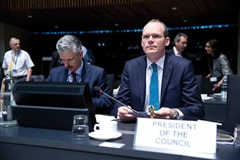Reaching our potential
 Ministerial Introduction · Simon Coveney TD
Ministerial Introduction · Simon Coveney TD
Ireland is on the cusp of new export opportunities in agri-food as CAP reform takes effect and the industry contributes strongly to economic recovery.
I am delighted to welcome the publication of the eolas magazine agri-food report, an excellent source of information on the promotion of Ireland’s food brand, innovation in the sector and dairy performance and outlook.
The Irish agri-food industry performance in 2013 demonstrates that the industry continues to play a vital role in economic recovery. Agri-food exports increased by 9 per cent to a record value of €10 billion in 2013, accounting for almost 12 per cent of all goods exports. An estimated 175,000 people are employed in the sector, accounting for 9 per cent of total employment, and making a particularly significant contribution to employment in rural areas. Around 1,200 food and drinks firms country-wide export to 170 countries around the world.
Ireland is a globally recognised trading nation, and has consistently provided high quality dairy and beef products to countries worldwide. Irish agri-food exports to emerging markets have grown substantially in recent years. China, for example, is now the third largest destination for Irish agri-food exports, after the European Union countries and the USA.
Food Harvest 2020 set out Ireland’s vision for the development of the agri-food sector through smart, green growth. The industry developed targets set out in Food Harvest 2020 are ambitious but achievable. The main targets in the Food Harvest report are by 2020 to increase the value of:
• primary output in the agriculture, fisheries and forestry sector by 33 per cent;
• value added production by 40 per cent; and
• agriculture, food (including seafood) and drink exports by 42 per cent.
Progress on these targets is monitored and reviewed on an ongoing basis by the Food Harvest High Level Implementation Committee (HLIC). The HLIC, which I chair, consists of the senior officials of all state agencies involved in the agriculture, food and fisheries sector. The third progress report – ‘Milestones for Success 2013’ – published last September, showed that the sector is on track to achieve our set targets.
 The abolition of milk quotas less than a year from now represents a unique opportunity for dairy expansion in Ireland. Ireland’s milk production has been artificially capped at 5 billion litres for the last 30 years. Food Harvest 2020 envisages an increase in milk output of 50 per cent in volume terms, accompanied by a matching increase in dairy output and exports. Farmers and dairy processors are now gearing up to prepare for this expansion.
The abolition of milk quotas less than a year from now represents a unique opportunity for dairy expansion in Ireland. Ireland’s milk production has been artificially capped at 5 billion litres for the last 30 years. Food Harvest 2020 envisages an increase in milk output of 50 per cent in volume terms, accompanied by a matching increase in dairy output and exports. Farmers and dairy processors are now gearing up to prepare for this expansion.
While the current situation and statistics show favourable conditions within the sector, I am also aware that there will be significant challenges to overcome to maximise its full potential. I urge farmers to familiarise themselves with all risk management issues such as price volatility, weather-related disasters, theft, injury and animal diseases. I also encourage farmers to take the appropriate steps and employ risk management techniques where possible.
The agreement on CAP reform reached under the Irish EU Presidency last year is characterised by three broad themes:
• a greater emphasis on sustainability through Pillar 1 ‘greening’ measures and Pillar 2 environmental measures;
• generational renewal through supports for young farmers under both Pillar 1 and Pillar 2; and
• a continuing move towards greater market orientation, with support measures available only as a safety net.
The agreement also includes a range of flexibilities that allow member states to pursue targeted policies suited to their individual circumstances and agricultural production systems. The agreement provides a sound basis for the sustainable development of the agriculture sector and gives it the best possible chance of achieving all of the objectives set out in the Food Harvest 2020 strategy.
I look forward to continuing to work with all of the stakeholders involved to help the Irish agri-food industry to reach its full potential, while at the same time continuing to make a significant contribution to Ireland’s economic recovery.





